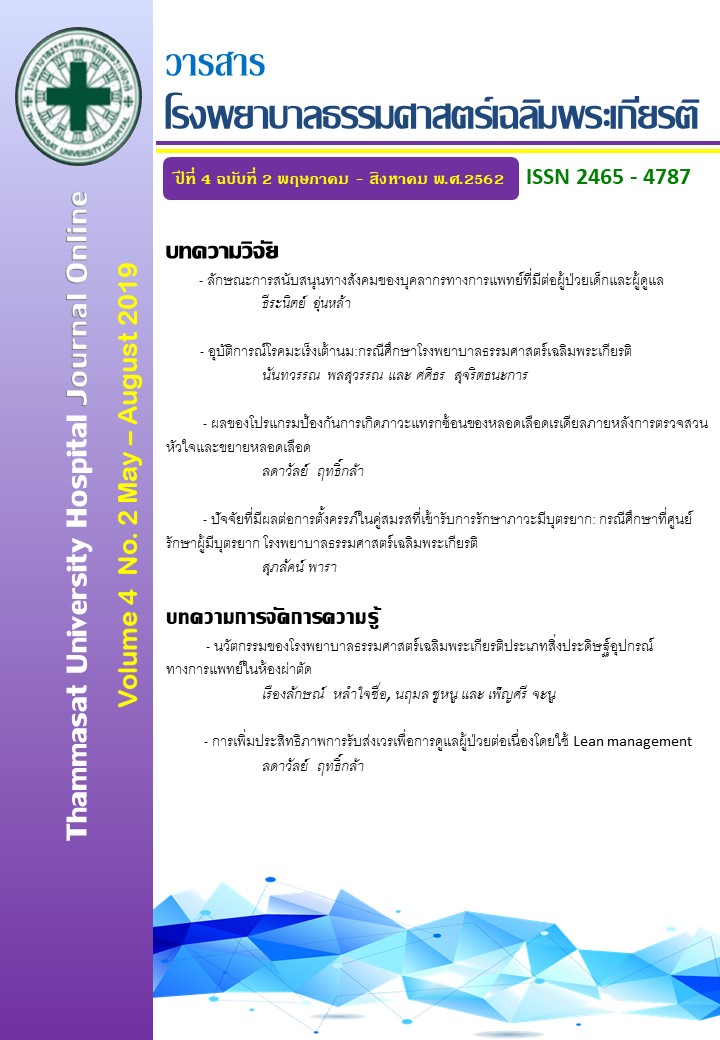Factors Influencing Pregnancy rate in Intrauterine Insemination among Infertile Couple: A Study in the Fertility Center, Thammasat University Hospital
Keywords:
intrauterine insemination, pregnancy rate, infertileAbstract
Background: Artificial intrauterine insemination (IUI) is the first method to treat infertility in which the married couple is interested because it is uncomplicated, inexpensive and also has less complications method when compared to the In Vitro Fertilization. However, its clinical pregnancy rate (CPR) is only 5-10 percent and there are many influencing factors effecting to its success. Previous researcher show conflicting data about these facts.
Objective:To determine factors influencing the clinical pregnancy rate of the artificial
insemination in fertility treatment.
Methodology: A retrospective cohort study was conducted at Thammasat Fertility Center from 2017 to 2018. Qualitative data were compared using Chi-square test or Likelihood Ratio when available, and quantitative data were compared using parametric (t-test) or nonparametric (Mann-Whitney) tests as appropriate. A multiple regression analysis was performed to identify prognosis factors. P<0.05 was considered statistically significant.
Result: Among 625 IUI cycles, the clinical pregnancy rate was 8.6%. Multiple regression analysis revealed that women age (≤34 years), BMI (25 to <30 kg/m2 and 30 to <35 kg/m2), duration of infertility (≤1 years) and number of preovulatory follicle (1 follicle) significantly affects pregnancy rate during IUI treatment.
Conclusion: Women age, body mass index, duration of infertility and number of preovulatory follicle were the main influencing factors associated with clinical pregnancy rate in artificial insemination.
References
Wadhwa L, Fauzdar A, Wadhwa SN. An Intrauterine Insemination Audit at Tertiary Care Hospital: A 4½ Years' Retrospective Analysis of 800 Intrauterine Insemination Cycles. J Hum Reprod Sci. 2018;11:279-85.
วิสันต์ เสรีพงศ์. การดูแลเบื้องต้นในคู่สมรสที่มีบุตรยาก. Chula Med J. 2003;47:193-208.
Albano C, Platteau P, Nogueira D, Cortvrindt R, Smitz J, Devroey P. Avoidance of multiple pregnancies after ovulation induction by supernumerary preovulatory follicular reduction. Fertil Steril. 2001;76:820-2.
Ghaffari F, Sadatmahalleh SJ, Akhoond MR, Eftekhari Yazdi P, Zolfaghari Z. Evaluating The Effective Factors in Pregnancy after Intrauterine Insemination: A Retrospective Study. Int J Fertil Steril. 2015;9:300-8.
Thijssen A, Creemers A, Van der Elst W, Creemers E, Vandormael E, Dhont N, et al. Predictive value of different covariates influencing pregnancy rate following intrauterine insemination with homologous semen: a prospective cohort study. Reprod Biomed Online. 2017;34:463-72.
Dinelli L, Courbiere B, Achard V, Jouve E, Deveze C, Gnisci A, et al. Prognosis factors of pregnancy after intrauterine insemination with the husband's sperm: conclusions of an analysis of 2,019 cycles. Fertil Steril. 2014;101:994-1000.
Merviel P, Heraud MH, Grenier N, Lourdel E, Sanguinet P, Copin H. Predictive factors for pregnancy after intrauterine insemination (IUI): an analysis of 1038 cycles and a review of the literature. Fertil Steril. 2010;93:79-88.
Ashrafi M, Rashidi M, Ghasemi A, Arabipoor A, Daghighi S, Pourasghari P, et al. The role of infertility etiology in success rate of intrauterine insemination cycles: an evaluation of predictive factors for pregnancy rate. Int J Fertil Steril. 2013;7:100-7.
Baldawa P, Baldawa S, Sarda R, Kamdi S. Predictive factors affecting pregnancy rate after intrauterine insemination: A retrospective study. RCHS. 2017;1:1-7.
Yildirim G, Turkgeldi LS, Koroglu N. Predictive factors for pregnancy outcome following controlled ovarian stimulation and intrauterine insemination. J Pak Med Assoc. 2017;67:422-7.
Luco SM, Agbo C, Behr B, Dahan MH. The evaluation of pre and post processing semen analysis parameters at the time of intrauterine insemination in couples diagnosed with male factor infertility and pregnancy rates based on stimulation agent. A retrospective cohort study. Eur J Obstet Gynecol Reprod Biol. 2014;179:159-62.
Yavuz A, Demirci O, Sozen H, Uludogan M. Predictive factors influencing pregnancy rates after intrauterine insemination. Iran J Reprod Med. 2013;11:227-34.
Habibzadeh V, Nematolahi Mahani SN, Kamyab H. The correlation of factors affecting the endometrial thickness with pregnancy outcome in the IUI cycles. Iran J Reprod Med. 2011;9:41-6.
Isa AM, Abu-Rafea B, Alasiri SA, Binsaleh S, Ismail KH, Vilos GA. Age, body mass index, and number of previous trials: are they prognosticators of intra-uterine-insemination for infertility treatment? Int J Fertil Steril. 2014;8:255-60.
Wang JX, Warnes GW, Davies MJ, Norman RJ. Overweight infertile patients have a higher fecundity than normal-weight women undergoing controlled ovarian hyperstimulation with intrauterine insemination. Fertil Steril. 2004;81:1710-2.
Souter I, Baltagi LM, Kuleta D, Meeker JD, Petrozza JC. Women, weight, and fertility: the effect of body mass index on the outcome of superovulation/intrauterine insemination cycles. Fertil Steril. 2011;95:1042-7.



